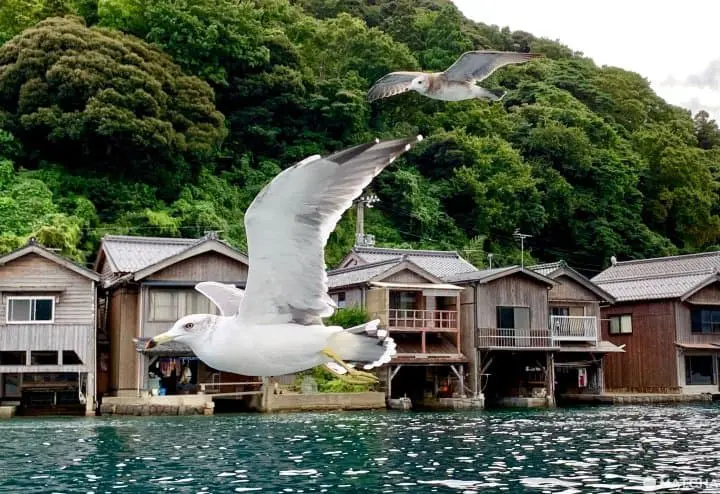Ine, Kyoto: Beautiful Daily Life In A Scenic Seaside Town

Kyoto's northern coast is famous for the seaside town of Ine and its unique funaya boathouses. This article, however, focuses on the everyday lives of locals, which gives unparalleled beauty to this town. Head to Ine if you're looking for a relaxing break from the city.
A Trip Full of Beauty in Ine

Ine—with a population of 1,800—is a small fishing town on the Tango Peninsula in northern Kyoto. When our writer used to live in northern Kyoto, he visited Ine and was struck by the beautiful scenery and the locals. This strong impression remains with him to this day.
The town is famous for its scenery of boathouses lined up on the water, but the true beauty of Ine lies in the ordinary life of its residents. Whenever the writer visits Ine, he takes a stroll through the town. It's during the walks that he encounters Ine's true beauty. The architecture, scenery, sights and sounds of everyday life are all elements that make this seaside town special.
Funaya: The Foundation of a Fishing Town

Picture from Discover A New Kyoto! 5 Things To Do At Kyoto By The Sea
Ine has very little land that is suitable for development. Residents, therefore, have had to find creative ways of building homes. As a result, the funaya (boathouse) was invented so people could live on the water.
Buildings in Ine are divided into two categories: the funaya are located by the sea, while the omoya (the main or manor house) are by the mountains. Sunlight shines through the gaps between the houses, which makes the water shimmer.

The first floor of a funaya is used as a garage for fishing boats and equipment. From their garages, fishers can go directly out to sea. On the second floor is the living space. Some funaya even operate as local inns. Staying at a funaya is a fantastic way to experience local life.
Learn Local History from a Captain

If you visit Ine, you'll likely want a view of the funaya out at sea. For that we recommend riding the sea taxi. The sea taxi sails around the bay in about a half-hour. It's also one of the writer's fondest memories here.
Though named taxis, these are actually small tour boats. If you place a request over the phone, the captain of your boat will give you a tour of the bay. Using Japanese and some simple English, the captain can teach the history and industries of Ine, including how this charming town came to be.

When our writer embarked on a tour, the captain stopped the boat partway and started distributing shrimp rice crackers. If you throw the crackers into the sea, seagulls will come to feast. This is a great opportunity to take photos!
The Fishermen of Ine

Photo taken with the parents' permission
The children of Ine grow up next to the sea and mountains. After school, kids can be seen taking their fishing rods to the sea. They know a lot more about the fish they catch than we adults from the city!
Yellowtail Rice Bowl: Tasting the Fresh Bounty of the Sea

Ine is Japan's largest producer of yellowtail, alongside Himi in Toyama Prefecture and the Goto Islands in Nagasaki Prefecture. If you visit Ine during the winter, try the yellowtail rice bowl for a taste of truly fresh seafood!
Funaoto: An Inn That Bridges Cultures

With a history spanning 75 years, Guest House Funaoto is an inn that once was an omoya for a local family. The harbor lies just outside the inn from which you can hear the seagulls and fishermen chatting.
The interior design retains the feel of Japanese aesthetics, with small decorations on the walls. While it exudes the warmth of a traditional home, the accommodations and electric appliances are all brand new.

The owner of Funaoto, Ms. Jun, is one of the few non-Japanese residents here. She has lived in Ine for seven years. In addition to Japanese, she can also speak Mandarin, Cantonese, and English.
Ms. Jun previously worked at a tourism office. Today, she welcomes visitors to Ine with stories about the town's history and lifestyle.
Take a Nighttime Stroll

If your travel schedule allows you, try staying overnight to enjoy the nighttime scenery of Ine. The tranquil streets create an atmosphere that is different from the day.
Nighttime Ine is very quiet. Besides the occasional jogger, you won't come across anyone outside.
Hamauri: Visit an Early Morning Fish Market

Early the next morning, Ms. Jun took our writer to the hamauri fish market at the harbor. Hamauri is a local tradition where locals come to buy fresh fish. Watching the hamauri firsthand, the writer witnessed the deep bond forged between the fishers and the locals.
In particular, the fishermen are mindful of Ms. Jun, chatting with her regularly and making her feel welcome. They were also bright and cheerful with our writer during his visit to the morning fish market.
Ine: A Fishing Town That Charms Visitors
The more you visit Ine, the more you'll fall in love with this fishing town. When our writer visited for the first time, he was initially captivated by the funaya boathouses. But, with each additional trip, he slowly became drawn to the locals and their everyday lives.
Over time, you might forget the scenery on your trip. However, you'll never forget the beautiful people you fatefully come across. It's these human encounters that we remember.










































![[Coupon Available] Attention Overseas Winter Sports Fans! Nagano's Sports Depot Has Evolved](https://resources.matcha-jp.com/resize/720x2000/2026/01/05-254819.webp)
![[2 hours from Tokyo ] 10 Quiet and Breathtaking Views of Mount Fuji in Yamanashi Hokuto City , Yamanashi - Part 2](https://resources.matcha-jp.com/resize/720x2000/2025/12/16-253037.webp)

![[Reopening in March 2026] Ikoma Sanjo Amusement Park Park, 45 minutes from Osaka , with free admission](https://resources.matcha-jp.com/resize/720x2000/2024/08/28-194409.webp)